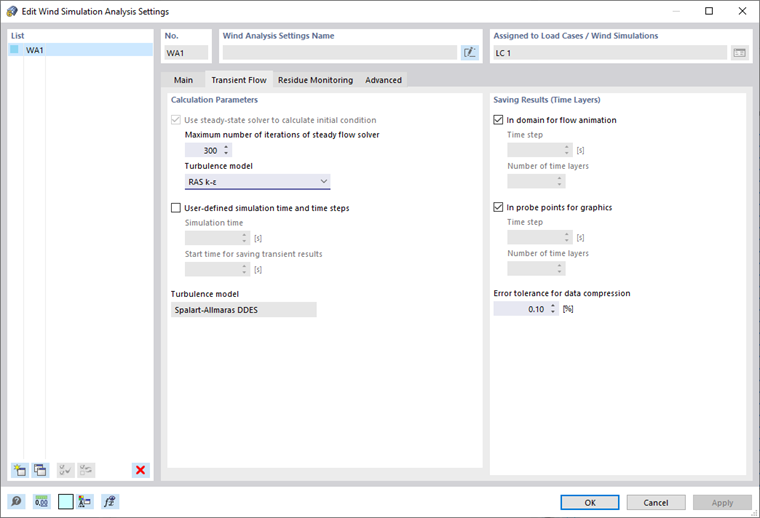This tab is available when the Transient Flow simulation type is selected on the "Main" tab.
Calculation Parameters
The "Use steady flow solver to calculate initial condition" option is set by default. The initial condition will thus be determined by the steady state solver. You can also define the "Maximum number of iterations" for this calculation. For the initial steady state calculation, you can choose between two turbulence models, RAS k-ε or RAS k-ω. The first option (RAS k-ε) is set as the default, see Section Note on Turbulence for more information on turbulence models.
![]()
The "User-defined simulation time and time steps" option is disabled by default so that the calculation process is controlled automatically. This is the recommended approach. If you activate the check box, you can set the "Simulation time" and the "Start time for saving transient results" individually. It is advisable only for experienced users, however, to change the settings at their discretion. Please note that inappropriate adjustments may cause a large amount of data to be stored on disk (tens or hundreds of GB). This may significantly slow down the calculation as well as the subsequent work with the program.
The "Simulation time" is the real time of the wind flow to be calculated. The default value (given by the automatic setting) corresponds to ten times the time required for the wind to pass through the entire length of the tunnel at the given inlet speed.
The "Start time for saving transient results" is the time from which transient results are to be stored. You can thus avoid data from being saved in the initial phase of the calculation in which the numerical solution does not yet have the correct values.
The transient calculation allows for the utilization of more advanced LES turbulence models. So far, only the "Spalart-Allmaras DDES" turbulence model is available in RWIND. For more information, see Chapter Turbulence .
Saving Results (Time Layers)
This area provides some options for saving the results of animations and graphs. The "In domain for flow animation" check box controls whether the transient results in the entire computational domain (in the nodes of the computational mesh) are stored. You can enter the "Time step" and "Number of time layers" when you have activated the user-defined option in the "Calculation Parameters" area (see above). Those results are used for the animation of transient flow and for the graphs of the time development of drag forces and other quantities in the point probes defined after the calculation.
When you activate the "In probe points for graphics" option, the transient results are stored in the point probes defined before the calculation. You can set the "Time step" after which those data are to be stored (only for user-defined settings).
The "Error tolerance for data compression" controls the settings for saving the transient results data. You can find more information in Chapter Transient Flow .
